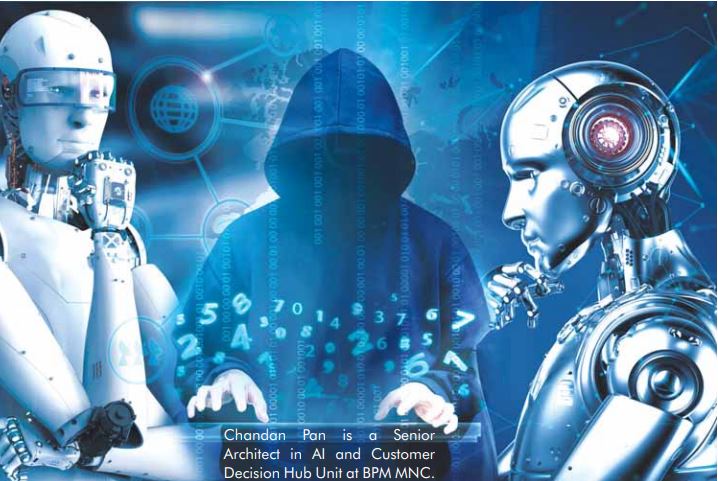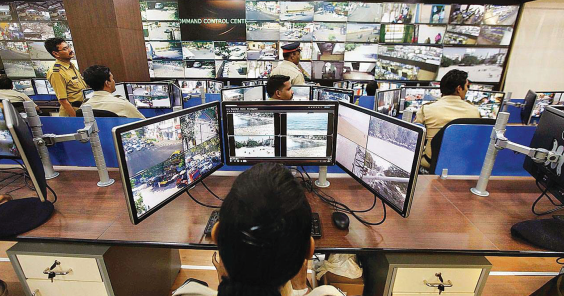Chandan Pan is a Senior Architect in AI and Customer Decision Hub Unit at BPM MNC.
Data is the new oil in the digital economy, and the 21st century is now witnessing the power of Artificial Intelligence and Data Science as a tool in law enforcement in preventing and detecting cyber-crimes and policing systems.With the help of AI, it may be possible for a machine to act and behave like a human and learn from experiences of law and order. Today, AI is part of our day-to-day life. Starting from our small daily needs to organisations, AI is now being used inevery corner of our world, from automated driving of a car to generating code for software. As technology is evolving day to day, new methods and techniques are also being used by criminals in executing cyber offences. By recognising the patterns of digital footprints applied by the criminals, AI can detect a signal in identifying a digital threat in the policing system with the help of the following design:
With the need of the hour, law enforcing departments are also trying to explore latest AI-driven technology to prevent and detect crimes by data-driven approaches. This technology holds great promise to detect various types of crimes in the near future. These crimes pose personal, financial, and economic risk, which turns into complex challenges for law enforcement departments in investigation and prosecution. With the advent of AI, it can seamlessly increase the operational efficiency in the policing system by applying Intelligent Automation (IA), transforming data into insightful information, making decisions faster, and sometimes more accurately than humans.
Various milestones in AI can be useful in solving the complex problems in crime detection:
The advancement in data driven smart technologies has transformed the shape of criminal activities. Cybercrime comprise of many crimes, including various hacking techniques, frauds, online provocations, etc. The law enforcement department is using technologies to collect data from various digital channels like camara, microphones, social media monitoring for threats, security or violation of governance. AI and Deep Learning interpret, analyse and train itself from these varieties of data to identify ordinance violations or emerging threats. AI technologies such as Computer Vision, Image Processing, Facial and License Plate Reading, Speech Identification or Handwriting Recognition can help the police quickly and accurately identify individuals wanted for serious crimes, as well as missing vehicles or people.
One of the keys areas where AI is widely used is Human Behaviour Analysis. With the advent of big data technology and cloud repositories, AI can use vast amounts of human demographical, behavioural, transactional, and movements in social media to recognise patterns and anomalies, offering promising solutions to complex challenges beyond human capacity.
Harnessing the power of various statistical and mathematical algorithms, AI can read, process, analyse large volumes of unstructured datasets like social media posts, sms, network logs and texts from dark web forums to discover mysterious cyber connections and identify potential threats. This data science-driven strategy enables law enforcement to spotlight various stages of investigations, helps in resource allocation, and can predict various threats well in advance. It can, therefore, perform risk assessment and protect the society.
Traditional forensic framework sometimes involves manual investigation of digital footprints consuming considerable time and cost. Using the power of deep learning, digital forensic process can be accelerated in crime investigations to provide information for action.
Machine Learning (ML) helps in predictive policing where smart technology helps to forecast when and where a future crime will occur. Using criminology reports, predictions are made regarding when and by whom a crime may occur. ML also predicts the severity of the crime, enabling continuous monitoring of suspects’ networks and behaviours. For instance, one could forecast a significant rise in assaults and robberies in a specific area. Inputs may include types of locations or social circumstances, allowing for 24×7 system monitoring and the creation of a real-time risk score. For example, one might forecast an increase in residential burglaries along secluded bus routes on weekdays just after office hours, or one might forecast an increase in jewelry stores break-ins over the weekend or at certain time of the year. From such forecasts, security can be increased to prevent crime or apprehend criminals. AI also plays a key role in preventing and detecting malware, thereby strengthening software systems and reducing the risk of malware infections.
Text Analytics and Natural Language Processing (NLP), is a part of AI which can generate signals from unstructured text, like reports, WhatsApp messages, social media content, etc. It uses various algorithms to produce threat intelligence, read the sentiments and emotions of the user, and provide intent and summary of the text. Another application of text analytics is detection of fabrication in media news and identification of fake news.
Indeed, for over a century before the advent of AI, the police have been using their experience, hints from informants, complaints from the public, police craft lore, and amazingly, simple mapping procedures to do predictive policing. Thanks to increased data volumes, advanced algorithms, and improvements in computing power and storage, AI has elevated this capability to the next level. While the evidence of forecasting accuracy in predictive AI for policing systems can be inconsistent, AI-based tools make it easier to identify patterns and trends that might elude human detection. This enables law enforcement agencies to allocate resources more effectively and prevent crime. Similarly, AI can be utilised to identify individuals who may pose a risk to public safety.
The Singapore Civil Defence Force (SCDF) has recently implemented Unmanned Aerial Vehicles (UAVs) to help in smart observing activities in public spaces, such as complex rescue operations, surveilling monitoring areas, critical fire tracking, etc., by providing an intelligent bird’s-eye view of an operation. Various Internet of Things (IoT) devices with autonomous navigation and various mapping statistical and mathematical algorithms can enhance the capabilities of UAVs to improve the effectiveness of surveillance and response operations.
All technological advancements have their trade-offs, and predictive policing is no exception. The algorithms used may shift oversight concerns from police officers and their superiors to technical details of forecasting algorithms. Moreover, the data used to train algorithms can be flawed, as reported crimes may not always align with crimes committed, and reported crimes may be mischaracterised. The yardstick for forecasting accuracy is current practice, not perfection. The guiding question is whether predictive policing leads to improvements in accuracy beyond current procedures. While there have been some successes, there are no definitive conclusions yet.
Despite its numerous features and advantages, implementing AI in cybercrime detection and policing systems poses several challenges. One key challenge is the collection, storage, and preprocessing of raw data to remove noise for effective algorithm processing. Additionally, there may be biases in both the data and the algorithm, potentially leading to inaccurate predictions by the system and software.
We will conclude the topic although the ability of machine to think like human in analysing crime data, identify patterns of crimes, and proactive generate threat intelligence has been reformed in last one decade, but this is just the beginning. However, AI may not be able to fully replace humans’ existence in Law enforcement.By confirming transparent decision-making system, we should maximise the usage of implementing state-of-the-art AI in law enforcement system of our society with equality and integrity to avoid any adverse consequence. In conclusion, while machines have made significant strides in analysing crime data, identifying patterns, and generating proactive threat intelligence over the past decade, this is just the beginning. However, it is important to acknowledge that AI may not completely replace human involvement in law enforcement. By ensuring transparent decision-making systems, we can maximise the benefits of implementing state-of-the-art AI in our law enforcement systems with equality and integrity to avoid any potential adverse consequences.






